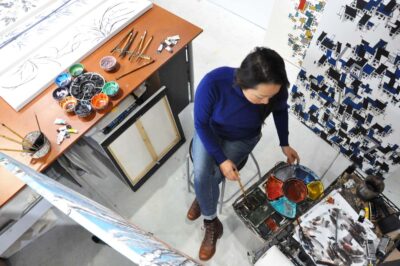


The Process

I utilize contemporary Chinese brushstrokes and empty space to create a sophisticated balance in my work. The materials used consist of handmade paper, ink made of pine soot, and watercolors. My method of applying color is a contemporary style of brushwork that consists of layering instead of soft washes. This allows watercolors to be vivid and bright with texture.
The handmade paper consists of silk, cotton, woodchips, and mulberry fibers that have been pressed together. Since the pieces are framed without glass but treated with a varnish, the artwork that has a velvety quality to the surface is not masked. The works on paper are stretched using a similar ancient process to that of mounting scrolls that dates back over a thousand years. Wheatpaste is applied to the back side of the artwork and a layer of backing paper is attached to the back to create resilience to the artwork since the paper that is painted on is tissue-thin. After a stiff brush is used to brush out the air bubbles between the two layers of paper the artwork is then glued just along the edges onto a board and allowed to dry. This drying period takes two weeks to a month depending on the humidity and temperature.
After the artwork has dried and shrunken so that the surface is flat as a board, it is then removed carefully from the drying boards and wrapped around the gatorboard. Gatorboard is high-density foam board with a wood veneer on the surface to keep it from warping.
During the time we lived in Taiwan, and out of necessity since I was painting so prolifically, Chris took an interest in Chinese mounting. He apprenticed under a few artisans in Tainan, Taiwan for five years and since our return to the states, he started a business in art restoration, specializing in shoji, scrolls, and works on paper.

